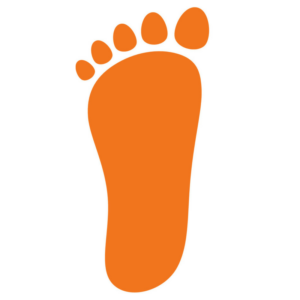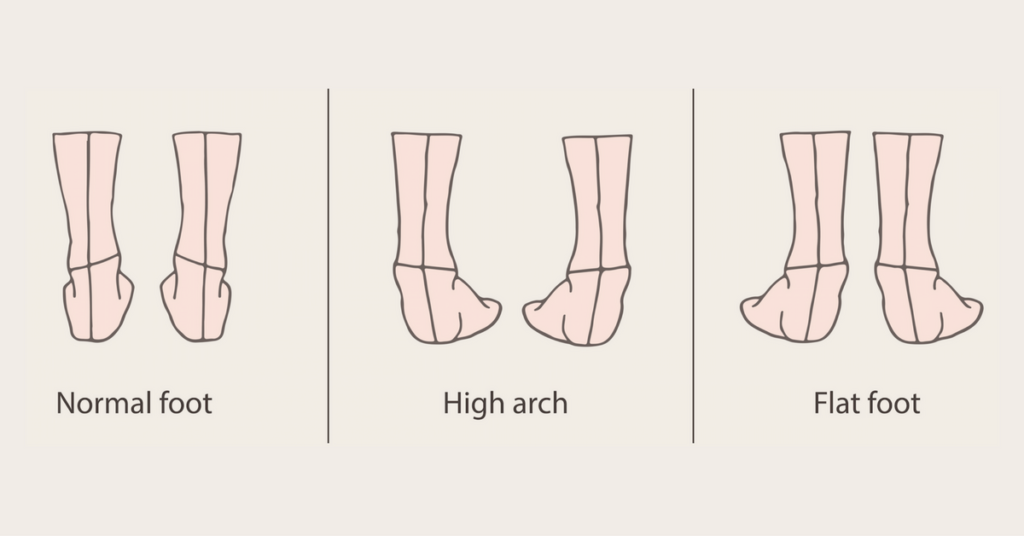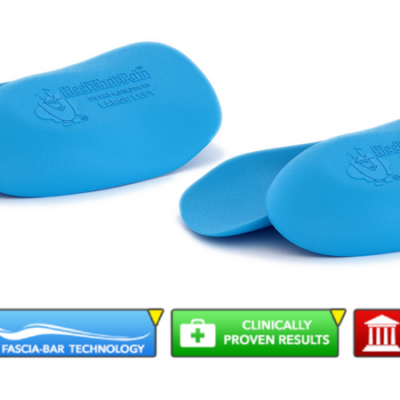Learn Your Foot Arch Type With The Wet Test
How High Are My Arches?
Most people can be categorized into three arch types: normal arches, high arches, and flat feet. Ideally, the arch of your foot curves slightly upward, which balances weight and impact optimally and keeps your foot muscles and ligaments healthy.
The height of a person’s arch is determined by the height of the navicular bone. Collapse of the longitudinal arches results in flat feet. A person with a collapsed longitudinal arch will likely over-pronate. This rolling inward of the foot can place additional stress and strain on the plantar fascia. A person with a high longitudinal arch essentially has a tripod type foot. The majority of the pressure will be placed on the heel, first and fifth metatarsals. A person with a high arched foot is also at risk for developing plantar fasciitis and other conditions due to the increased tension on the plantar fascia. Your plantar fascia plays a critical role in absorbing the impact from physical activity, distributing your weight evenly, and allowing you to move without pain.

Why Does My Arch Type Matter?
It’s important to know your arch type for several reasons. Most importantly, knowledge is power! Finding out whether you have normal arches, flat feet, or high arches provides you with the information you need to make good choices when buying new shoes and preventing injuries like plantar fasciitis.
Figuring out your arch type is easy, and can be done in just a few seconds!
Take the Foot Arch Test
The foot arch test is a simple way to determine whether you have flat feet or high arches! Just follow these easy instructions:
- Pour water into a shallow pan (the pan should be big enough to fit your foot, and the water should be just deep enough for all parts of the bottom of your foot to get wet).
- Step into the water with one foot, then carefully remove your foot from the pan of water and step onto a flattened brown paper bag or piece of cardboard that will show your footprint (don’t just lightly place your foot onto the paper bag/cardboard. Be sure to put your weight on it!).
- Remove your foot from the bag/cardboard and take a photo for reference
- Repeat the process with your other foot
What Do My Results Mean?
Carefully examine your footprints, or the photos you took of them. You should see one of three basic imprint types:
Normal Arches:

If the middle portion or arch of your footprint is just about halfway filled in with a noticeable curve along the arch, congratulations! Your arches are at the proper height to absorb and distribute the impact from walking and other physical activity.
Inserts Recommended for you: Original Heel Seats
High Arches:

If all you see in your footprint is your heel, the ball of your foot, and your toes (without much in between), you have high arches. This means your feet have an extra hard time absorbing impact and need extra cushioning and proper arch support.
Inserts recommended for you: Full Length High Arch Heel Seats
Flat Feet:

If your footprint looks like a complete foot (i.e., is totally filled in without much of an inward curve in the center), you likely have flat feet. This causes you to “pronate” when you walk or run (meaning, your foot rolls inward)–which is great for shock absorption but not so great for your knees and legs, or your chances of developing plantar fasciitis as your arch is strained.
Inserts Recommended for You: Original Heel Seats
How Else Can I Tell If I Have High Arches?
In addition to footprint test, you likely have high arches if you experience pain in the heel and ball of your foot, especially after running or other high impact sports, since high arches mean your feet have a harder time absorbing impact. High arches are much less common than flat feet, but supporting your high arch is no less important!
Ultimately, visiting your podiatrist will always provide you with the most accurate information about your foot type. Your podiatrist will be able to perform an in-depth foot exam and gait analysis to give you the most accurate diagnosis and treatment plan for any symptoms you are experiencing.
How Else Can I Tell If I’m Flat-Footed?
More signs you have flat feet include feet that tire easily when standing, aches and pains localized in the arch and heel of your feet, and swelling on the undersides of your feet. Another telltale sign of flat feet is that standing on your toes may be quite difficult.
How Else Can I Test Pronation?
If you’re worried you have flat feet and pronate when you walk or run, try the following tests:
Take a look at the outsoles of an old pair of running shoes. If you notice a lot of wear along the inside of the sole’s outside edge, it’s pretty likely your foot is rolling inward heavily as you walk or run.
Ask a partner to help you test for possible pronation. Stand on a flat surface and ask your friend to see if he or she can slide one finger beneath the arch of your foot. If not, it’s likely you have flat feet and are pronating when you walk!
Which Shoes Should I Wear for My Arch Type?

Normal Arches:
Keep your arches in great shape with shoes that have firm, thick soles, proper cushioning, and keep your heel stabilized (your heel should sit snugly in the back of your shoe).
Flat Feet:
If you have flat feet, it’s extra important to buy shoes that keep your foot from rolling inward, or pronating excessively. Look for shoes with a thick, cushioned sole and lacing that allows you to restrict movement in the shoe. Add support for the flattened plantar fascia with Heel Seats.
High Arches:
Shoes with cushioning are extra important if you have high arches. The shoes you’re looking for are typically heavier on cushioning and less rigid. Slip in high arch supports to help redistribute weight more evenly along the bottom of the foot.
Flat feet or high arches don’t have to be a problem.
High or flat arches are nothing to be ashamed of. Everyone’s feet are different! Taking ownership of your foot type by properly supporting it with the right shoes and orthotics is the ticket to avoiding plantar fasciitis and enjoying pain-free activity. Heel Seats give your arches the support and cushioning they need–no matter their height! Whether you have high arches, normal arches, or flat feet, there’s an arch support insert just for you. If prefabricated orthotics do not completely eliminate your foot pain after about one month, schedule an appointment with your podiatrist.






